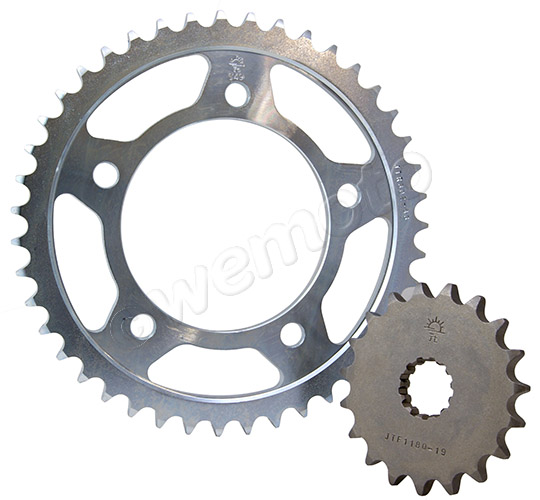Product Code : PKAG1652
2 In Stock
£35.07 Incl. VAT
| Make | Model | Description | Year | Country |
|---|


Contains:
One split link is included with the drive chain
As well as using solid bushing, which can last 1.2 to 4 times as long as chains without, DID's HD Heavy Duty chain features thicker plates than the standard chain, and its tensile strength is roughly 20% higher. As with all DID chains, it is made with the latest chain manufacturing technology by DID's experienced engineers in Japan, at the high quality DID is so renowned for.
All DID chains are made in Japan.
| Pin Length | Roller Diameter | Plate Thickness | Weight | Tensile Strength |
|---|---|---|---|---|
| 18.90mm | 8.50mm | 2.0mm | 1.00kg per 100 links | 23.4KN |

JT is the best selling aftermarket sprocket in the world. Using the finest raw materials and cutting-edge technology in production, CNC computer design and precision machining, JT ensures maximum durability and performance.
JT front sprockets are made with SCM420 chromoly steel alloy, while the rear sprocket is manufactured with ultra-durable high-carbon C49 steel.
Please note, the sprockets in this picture are for example only
Returns
We hope that you are happy with your order, however, there may be instances where you wish to return an item. We ask that customers return items unused and with their original packaging. All returns should include a covering note stating the reason for the return and the order number clearly marked. Please retain the proof of postage until we have confirmed receipt of the items. We recommend sending by a recorded postage method. Refunds will be processed by the original payment method. If you paid on card, it can take up to 7 days to appear back in your account, with PayPal refunds taking up to 30 days refund if you've simply changed your mind, you have 30 days from the date of purchase to return your item(s) for a refund. Customers are responsible for return shipping costs where items are supplied correctly.
Exchanges
We allow customers up to 6 months after the purchase date to return the item for exchange, provided the item is in re-saleable conditions and proof of purchase can be established.
Supply errors
We ask that customers report supply errors as soon as possible after delivery. We reserve the right to decline issues reported beyond 6 months of the purchase date. Please check your order thoroughly on receipt. Where goods are supplied in error, or arrive damaged, we will cover all shipping costs and exchange or refund in full. We reserve the right to charge a 15% restocking fee for items that are returned in poor condition or outside of the accepted time period.
Electrical Items
Please note that when fitting electrical parts these can be damaged by the same faulty electrical system that caused the initial failure and in such circumstances these parts cannot be returned for a refund
Fitting Issues
Where customers experience issues fitting parts to their vehicle, we will always endeavor to thoroughly investigate and rectify where possible. We will first try to ascertain that you have purchased for the correct model of bike and that no modifications have been made. We cannot be held liable for issues fitting standard parts to non-standard or modified vehicles.